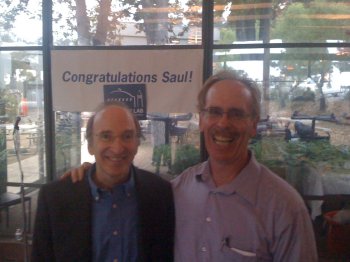This Year’s Physics Nobel Prize in the Genesis of Hands-On-Universe.

Saul Perlmutter, Brian P. Schmidt and Adam G. Riess won the award for their contribution to the discovery of Dark Energy, one of the most important turning points on our understanding of our Universe. Carl Pennypacker, president of the Global Hands-on Universe Association was a co-founder of the Supernova Cosmology Project (SCP), the project that led Perlmutter and his team to the discovery of Dark Energy. In the early days of the project Carl and some colleagues introduced the idea to schools and had actually students discovering supernovas in the classroom.
Both Hands-on Universe (HOU) and the SCP were co-founded by Carl Pennypacker and seemed to have an interesting set of connections. The supernova project started when Luis Alvarez and Rich Muller had a conversation that it was time to try again some old experiments to understand supernovas.
In the spirit of the times, Carl and the members of the team just did the project, which involved finding telescopes, building CCD cameras, writing software, and automating telescopes. The nearby supernova search led to the distant or deep supernova search. Carl Pennypacker helped develop the project at the Anglo Australian Telescope (AAT), and helped build the team. They developed software and started to understand how to undertake such work. Weather at the AAT proved to be somewhat unreliable, so they moved to the Isaac Newton Telescope (INT) in the Canary Islands. There they found their first supernovae, and wrote the first papers. After the INT work, Saul Perlmutter took over leadership of the project, and moved the search to the 4 meter telescope in Cerro Tololo, Chile. This is where the bulk of the supernovae were found, which then led to the discovery of Dark Energy.
Both HOU and SCP projects were based on a number of technical breakthroughs at the time – the debt of reliable CCD’s, automated telescopes, inexpensive computers, and the Internet. Such technologies could then allow a lot of observations, which were necessary if one was trying to serve students or search for rare supernovae. The supernova search came first, and then when teachers came to Carl’s lab to work on the supernova search, they said “we should use this in our classroom”. Hence, HOU was born.
The team got some funding, developed curricula, teacher training materials, software, and slowly, at last telescope networks that works. This eventually led to Global HOU, with many nations in Europe (EUHOU) contributing to the project, including software, curriculum, and other tools for helping to change education. In 2008 the Global Hands-on Universe Association (GHOU) was formally created in Portugal and during the International Year of Astronomy 2009 GHOU took the lead of one of the cornerstone projects, the Galileo Teacher Training Programme. This is Carl’s mission nowadays, making sure kids all over the world have the possibility to find the wonders of scientific research in their classroom and have the power to change the word.
In the words of Tim Barclay, co-founder of Hands-on Universe: How many high school students can say, “Hey, I know a lot about how those Nobel Prize winners have been studying Type Ia Supernovas, because that is what I have been doing too. I have downloaded images of a supernova, measured the brightness and analyzed the supernova light curve in order to determine the distance to the supernova. Sure, they got a Nobel Prize, but I’m right up there at the cutting edge with them. Now the question is why the expansion of the Universe is accelerating, and they don’t know the answer and neither do I, so we really are all in this together.”
Carl and HOU Teacher Resource Agents reflect on this honor and its relationship to the work of HOU teachers and students at Carl’s page:
http://handsonuniverse.org/about_hou/pennypacker.html
More links:
Galileo Teacher Training Programme:
http://www.facebook.com/galileoteachers
Global Hands-on Universe:
http://www.facebook.com/GlobalHOU
European Hands-on Universe:
http://www.facebook.com/EuropeanHOU
The Nobel Prize 2011
http://www.nobelprize.org/nobel_prizes/physics/laureates/2011/
